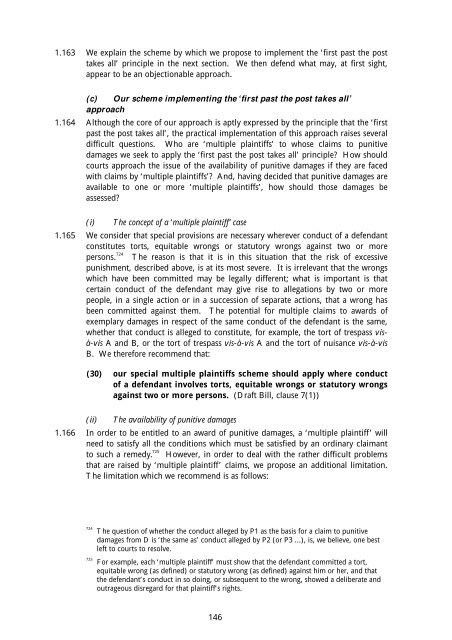Aggravated, Exemplary and Restitutionary ... - Law Commission
Aggravated, Exemplary and Restitutionary ... - Law Commission
Aggravated, Exemplary and Restitutionary ... - Law Commission
Create successful ePaper yourself
Turn your PDF publications into a flip-book with our unique Google optimized e-Paper software.
1.163 We explain the scheme by which we propose to implement the ‘first past the post<br />
takes all’ principle in the next section. We then defend what may, at first sight,<br />
appear to be an objectionable approach.<br />
(c) Our scheme implementing the ‘first past the post takes all’<br />
approach<br />
1.164 Although the core of our approach is aptly expressed by the principle that the ‘first<br />
past the post takes all’, the practical implementation of this approach raises several<br />
difficult questions. Who are ‘multiple plaintiffs’ to whose claims to punitive<br />
damages we seek to apply the ‘first past the post takes all’ principle? How should<br />
courts approach the issue of the availability of punitive damages if they are faced<br />
with claims by ‘multiple plaintiffs’? And, having decided that punitive damages are<br />
available to one or more ‘multiple plaintiffs’, how should those damages be<br />
assessed?<br />
(i) The concept of a ‘multiple plaintiff’ case<br />
1.165 We consider that special provisions are necessary wherever conduct of a defendant<br />
constitutes torts, equitable wrongs or statutory wrongs against two or more<br />
persons. 724<br />
The reason is that it is in this situation that the risk of excessive<br />
punishment, described above, is at its most severe. It is irrelevant that the wrongs<br />
which have been committed may be legally different; what is important is that<br />
certain conduct of the defendant may give rise to allegations by two or more<br />
people, in a single action or in a succession of separate actions, that a wrong has<br />
been committed against them. The potential for multiple claims to awards of<br />
exemplary damages in respect of the same conduct of the defendant is the same,<br />
whether that conduct is alleged to constitute, for example, the tort of trespass visà-vis<br />
A <strong>and</strong> B, or the tort of trespass vis-à-vis A <strong>and</strong> the tort of nuisance vis-à-vis<br />
B. We therefore recommend that:<br />
(30) our special multiple plaintiffs scheme should apply where conduct<br />
of a defendant involves torts, equitable wrongs or statutory wrongs<br />
against two or more persons. (Draft Bill, clause 7(1))<br />
(ii) The availability of punitive damages<br />
1.166 In order to be entitled to an award of punitive damages, a ‘multiple plaintiff’ will<br />
need to satisfy all the conditions which must be satisfied by an ordinary claimant<br />
to such a remedy. 725<br />
However, in order to deal with the rather difficult problems<br />
that are raised by ‘multiple plaintiff’ claims, we propose an additional limitation.<br />
The limitation which we recommend is as follows:<br />
724 The question of whether the conduct alleged by P1 as the basis for a claim to punitive<br />
damages from D is ‘the same as’ conduct alleged by P2 (or P3 ...), is, we believe, one best<br />
left to courts to resolve.<br />
725 For example, each ‘multiple plaintiff’ must show that the defendant committed a tort,<br />
equitable wrong (as defined) or statutory wrong (as defined) against him or her, <strong>and</strong> that<br />
the defendant’s conduct in so doing, or subsequent to the wrong, showed a deliberate <strong>and</strong><br />
outrageous disregard for that plaintiff’s rights.<br />
146
















